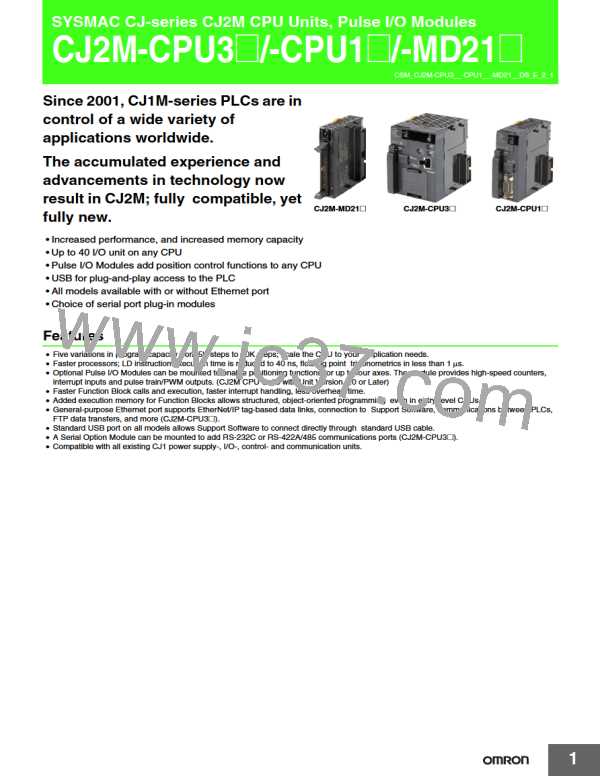CJ2M-CPU3@/-CPU1@/-MD21@
CJ2M-
Items
CPU11/31
Normal Mode
CPU12/32
CPU13/33
CPU14/34
CPU15/35
Execution Mode
Ladder Logic (LD),
Sequential Function Charts (SFC),
Structured Text (ST), and
Instruction Lists (IL)
Programming Languages
Maximum number of definitions
Maximum number of instances
256
2,048
2,048
Function
Blocks
256
FB Program Area
20K steps
Cyclic tasks
Type of Tasks
Interrupt tasks (Power OFF interrupt tasks, scheduled interrupt tasks, I/O interrupt tasks, and external interrupt
tasks, and input interrupt tasks *3)
Tasks
Cyclic tasks: 128
Interrupt tasks: 256
Number of Tasks
Type of Symbols
(Interrupt tasks can be defined as cyclic tasks to create extra cyclic tasks. Therefore, the total number of cyclic
tasks is actually 384 max.)
• Local symbols: Can be used only within a single task in the PLC.
• Global symbols: Can be used in all tasks in the PLC.
• Network symbols (tags)*: I/O memory in the CPU Unit can be externally accessed using symbols,
depending on parameter settings.
* Supported only by the CJ2M-CPU3@.
• BOOL (bit)
• UINT (one-word unsigned binary)
• UDINT (two-word unsigned binary)
• ULINT (four-word unsigned binary)
• INT (one-word signed binary)
• DINT (two-word signed binary)
• LINT (four-word signed binary)
• UINT BCD (one-word unsigned BCD) *4
• UDINT BCD (two-word unsigned BCD) *4
• ULINT BCD (four-word unsigned BCD) *4
• REAL (two-word floating-point)
• LREAL (four-word floating-point)
• CHANNEL (word) *4
Data Type of Symbols
Symbols
(Variables)
• NUMBER (constant or number) *4
• WORD (one-word hexadecimal)
• DWORD (two-word hexadecimal)
• LWORD (four-word hexadecimal)
• STRING (1 to 255 ASCII characters)
• TIMER (timer) *5
• COUNTER (counter) *5
• User defined data types (data structures)
Maximum Size of Symbol
32k words
Array Symbols (Array Variables)
Number of Array Elements
One-dimensional arrays
32,000 elements max.
Number of Registrable Network
Symbols (Tags) *6
2,000 max.
Length of Network Symbol (Tag)
Name *6
255 bytes max.
Encoding of Network Symbols (Tags)
Memory Capacity
*6
UTF-8
8,000 words (Up to 32k words × 4 banks when EM is specified in CX-Programmer)
Bits = 31, one-word data =16, two-word data = 8, four-word data = 4
1 to 2,550 ms (Unit: 1 ms)
Number of Samplings
Sampling Cycle
ON/OFF of specified bit
Data comparison of specified word
Data size: 1 word, 2 words, 4 words
Data
Tracing
Trigger Conditions
Comparison Method: Equals (=), Greater Than (>), Greater Than or Equals (≥), Less Than (<), Less Than or
Equals (≤), Not Equal (≠)
Delay Value
−32,768 to +32,767 ms
Memory Card (128, 256, or 512 Mbytes) (Use the Memory Cards provided by OMRON.)
EM file memory (Part of the EM Area can be converted for use as file memory.)
File Memory
Source/
Function block program memory,
Comment comment file, program index file,
Capacity: 1 Mbytes
Memory
symbol tables
Logical Ports
8 ports (Used for SEND, RECV, CMND, PMCR, TXDU, and RXDU instructions.)
64 ports (Used for SEND2, RECV2, CMND2, and PMCR2 instructions.)
LogicalPortsfor
Communications
Extended Logical
Ports
Commu-
nications
Class 3
(Connection Type)
Number of connections: 64
CIP
Communications
Specification
UCMM (Non-
Maximum number of clients that can communicate at the same time: 32
connection Type) Maximum number of servers that can communicate at the same time: 40
*3. Supported only by CJ2M CPU Units with unit version 2.0 or later. A Pulse I/O Module must be mounted.
*4. Cannot be used in Function blocks.
*5. Can be used only in Function blocks.
*6. Supported only by the CJ2M-CPU3@.
7

 OMRON [ OMRON ELECTRONICS LLC ]
OMRON [ OMRON ELECTRONICS LLC ]